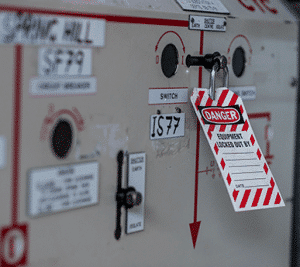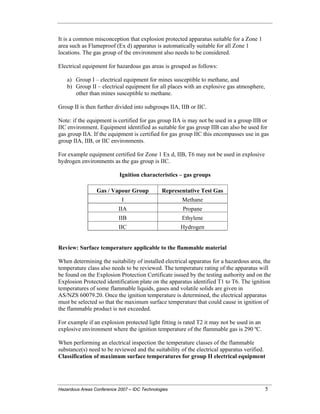Things about Roar Solutions
Things about Roar Solutions
Blog Article
The Greatest Guide To Roar Solutions
Table of ContentsRumored Buzz on Roar SolutionsTop Guidelines Of Roar SolutionsA Biased View of Roar Solutions
In order to protect installations from a possible explosion a technique of evaluating and categorizing a potentially unsafe location is called for. The function of this is to make certain the appropriate selection and setup of tools to eventually avoid a surge and to ensure safety and security of life.
(https://www.video-bookmark.com/bookmark/6634779/roar-solutions/)
No equipment ought to be set up where the surface area temperature of the equipment is more than the ignition temperature of the provided risk. Below are some usual dust hazardous and their minimum ignition temperature. Coal Dirt 380C 225C Polythene 420C (melts) Methyl Cellulose 420C 320C Starch 460C 435C Flour 490C 340C Sugar 490C 460C Grain Dust 510C 300C Phenolic Material 530C > 450C Aluminium 590C > 450C PVC 700C > 450C Residue 810C 570C The possibility of the danger being present in a focus high adequate to cause an ignition will certainly vary from location to area.
In order to classify this threat an installment is divided into areas of danger depending upon the amount of time the harmful is existing. These locations are referred to as Areas. For gases and vapours and dirts and fibers there are 3 areas. Area 0 Area 20 A harmful ambience is highly likely to be existing and may be present for extended periods of time (> 1000 hours each year) or perhaps continuously Area 1 Zone 21 A dangerous ambience is feasible however unlikely to be existing for lengthy periods of time (> 10 450 C [842 F] A classification of T6 suggests the minimum ignition temperature level is > 85 C [185 F] Harmful area electrical tools possibly created for use in higher ambient temperatures. This would certainly suggested on the score plate e.g. EExe II C T3 Ta + 60C( This implies at 60C ambient T3 will certainly not be gone beyond) T1 T1, T2, T3, T4, T5, T6 T2 T2, T3, T4, T5, T6 T3 T3, T4, T5, T6 T4 T4, T5, T6 T5 T5, T6 T6 T6 A T Course score of T1 means the maximum surface area temperature produced by the instrument at 40 C is 450 C. Presuming the associated T Class and Temperature score for the tools are ideal for the location, you can constantly use an instrument with a more rigorous Division rating than required for the area. There isn't a clear response to this inquiry sadly. It really does rely on the type of equipment and what repair work need to be performed. Devices with specific test procedures that can not be executed in the area in order to achieve/maintain 3rd party score. Need to come back to the factory if it is before the equipment's solution. Field Repair Service By Authorised Worker: Complex screening might not be needed however details treatments might need to be adhered to in order for the devices to keep its 3rd party score. Authorised employees should be utilized to do the work properly Repair have to be a like for like replacement. New element have to be taken into consideration as a direct replacement calling for no unique screening of the tools after the fixing is complete. Each tool with a hazardous ranking need to be examined independently. These are detailed at a high level listed below, but also for even more comprehensive information, please refer straight to the standards.
Roar Solutions Fundamentals Explained
The tools register is a detailed database of devices records that includes a minimum set of fields to recognize each item's area, technological specifications, Ex lover category, age, and ecological data. This info is important for tracking and handling the equipment properly within unsafe locations. In contrast, for periodic or RBI tasting inspections, the quality will certainly be a mix of Comprehensive and Close assessments. The proportion of Thorough to Shut examinations will be figured out by the Tools Risk, which is assessed based upon ignition threat (the chance of a resource of ignition versus the likelihood of a combustible environment )and the unsafe location category
( Zone 0, 1, or 2). This variation will likewise influence the resourcing needs for work preparation. Once Great deals are defined, you can create tasting plans based upon the example dimension of each Whole lot, which describes the variety of random equipment things to be evaluated. To determine the called for sample dimension, two aspects require to be reviewed: the size of the Great deal and the category of inspection, which indicates the degree of effort that must be applied( reduced, regular, or increased )to the examination of the Great deal. By combining the category of evaluation with the Whole lot size, you can after that develop the suitable rejection requirements for an example, implying the allowed number of malfunctioning products found within that example. For more information on this process, please describe the Power Institute Guidelines. The IEC 60079 common suggests that the optimum period between examinations need to not surpass 3 years. EEHA evaluations will certainly additionally be conducted outside of RBI projects as part of scheduled upkeep and equipment overhauls or repairs. These assessments can be attributed toward the RBI example sizes within the impacted Whole lots. EEHA evaluations are performed to identify faults in electric equipment. A heavy racking up system is essential, as a solitary tool might have several faults, each with differing levels of ignition risk. If the combined rating of both inspections is less than two times the fault score, the Great deal is considered appropriate. If the Lot is still considered unacceptable, it should undergo a complete inspection or justification, which may cause stricter evaluation protocols. Accepted Whole lot: The reasons for any kind of faults are identified. If an usual failure mode is located, extra tools may call for maintenance. Mistakes are identified by severity( Security, Integrity, Housekeeping ), ensuring that urgent issues are assessed and dealt with promptly to minimize any effect on security or procedures. The EEHA database should track and videotape the lifecycle of faults in addition to the restorative activities taken. Applying a durable Risk-Based Evaluation( RBI )approach is important for making sure compliance and security in managing Electric Equipment in Hazardous Locations( EEHA) (high voltage courses). Automated Fault Scoring and Lifecycle Administration: Effortlessly take care of mistakes and track their lifecycle to boost inspection precision. The intro of this assistance for risk-based inspection better strengthens Inspectivity's position as a best-in-class remedy for governing conformity, in addition to for any asset-centric examination use situation. If you are interested in discovering more, we invite you to ask for a demo and discover how our option can transform your EEHA management procedures.
The smart Trick of Roar Solutions That Nobody is Talking About

In regards to eruptive threat, an unsafe area is an environment in which an eruptive atmosphere exists (or may be expected to be existing) in quantities that need special preventative measures for the building and construction, installment and usage of devices. high voltage courses. In this short article we check out the obstacles faced in the office, the threat control steps, and the called for competencies to function securely
These materials can, in particular problems, create explosive atmospheres and these can have significant and unfortunate consequences. Most of us are familiar with the fire triangular remove any one of the three aspects and the fire can not occur, however what does this mean in the context of unsafe locations?
In many instances, we can do little about the levels of oxygen a knockout post in the air, however we can have significant influence on resources of ignition, for example electrical devices. Dangerous areas are recorded on the harmful area category drawing and are identified on-site by the triangular "EX" sign. Below, among various other crucial information, areas are divided right into three kinds depending upon the risk, the possibility and duration that an explosive ambience will certainly exist; Area 0 or 20 is regarded the most harmful and Zone 2 or 22 is deemed the least.
Report this page